Summary
- We estimate that 6.5-8.8% of EAs live in the San Francisco Bay Area and 5.3-7.3% live in London. Both are much larger than the next largest EA centre (New York).
- More EAs in our sample live in ‘Loxbridge’ (London, Oxford and Cambridge) than the SF Bay Area.
- The total percentage of EAs living in Loxbridge and the SF Bay Area combined is estimated to be between 14.5% and 19.5% (roughly 1-in-7 to 1-in-5).
- 50% of EAs live in the top 22 cities, 80% live in the top 100 cities out of 340 cities total.
- Almost a third (32%) of highly engaged EAs live in the SF Bay Area, London or Oxbridge.
- The share of EAs living outside the SF Bay Area, London or Oxbridge appears to be steadily growing with time.
It is well known that the EA community has historically been relatively heavily based around certain core geographic ‘hubs’ (e.g. the San Francisco Bay Area, London and Oxford). But to what extent, exactly, do EAs disproportionately live in these hubs or in a small number of other major cities? This is potentially of relevance for questions such as the allocation of community building resources across areas (see discussion here) and the extent to which the EA community might be neglecting EAs living elsewhere (see discussion here). In this post, we examine this question in more detail.
How many EAs live in the main hubs?
As the earlier EA Survey Geography post highlighted, the cities with the largest numbers of EA respondents were the SF Bay Area (162), London (134), followed by New York (95) and Boston/Cambridge (66). Oxford (44), Washington DC (43) and Sydney (43) were some way behind.
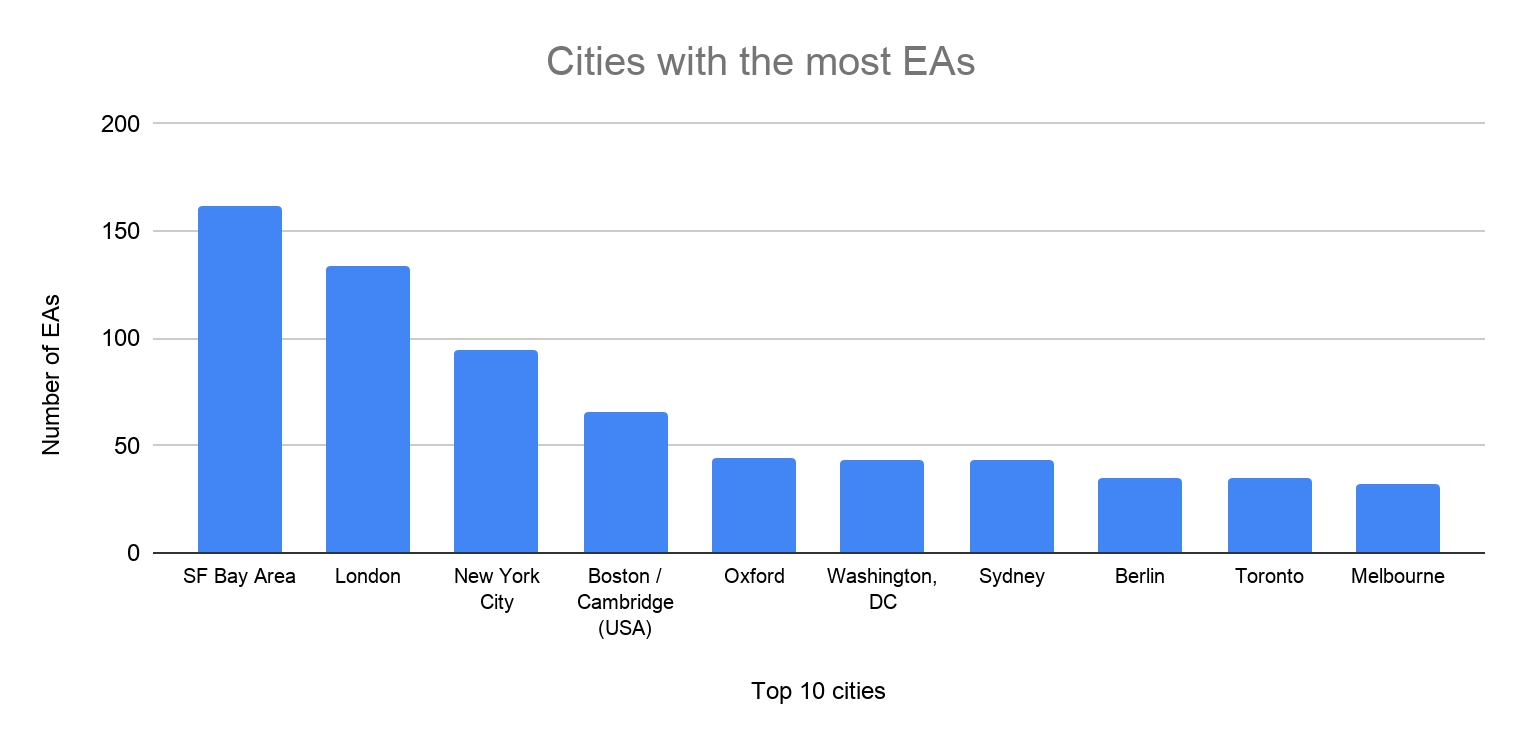
But what percentages of EAs overall do these numbers represent? Looking at these as percentages of those respondents who answered the question about which city they lived in gives the percentages in the second column in the table below. However, only around 75% of respondents answered this question. So as a proportion of total respondents, the percentages would be the somewhat lower figures in the third column of the table below. We expect that people living in major cities were probably more likely to answer the cities question than those living elsewhere, so the true percentage is probably somewhere between these two figures.[1]

Taking the figures in the table as a rough guide, it seems that the proportion of EAs living in the SF Bay Area or London specifically, likely falls somewhere between 6.5-8.5% and 5.5%-7.5% respectively, and somewhere between 12% and 16% live in the two combined.
Based on the number above, it seems that the SF Bay Area is the largest single centre for EA by quite some margin, with about 20% more EAs than London. Likewise, both have considerably more than the city with the next largest number of EAs (New York), with London being 40% larger and the Bay Area being 70% larger.
Some EAs have suggested that ‘Loxbridge’ is a hub comparable to the SF Bay Area in terms of geographic spread and travel times. Oxford (44) and Cambridge (21) both contain significantly fewer total EAs than London, but if we combine these into a single hub, then ‘Loxbridge’ is significantly larger than the SF Bay Area.
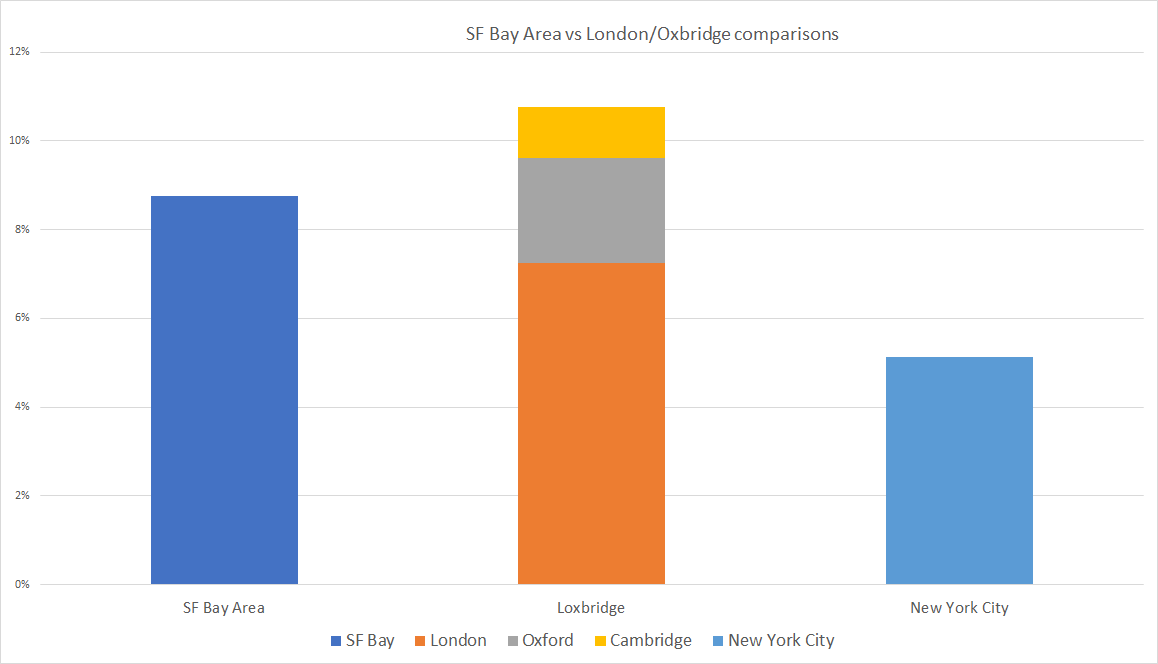
Combined, the SF Bay Area and Loxbridge, therefore accounted for 361 respondents, 19.5% (of EAs who indicated a city) or 14.4% (EA respondents overall).
Is this concentration of EAs just a reflection of the distribution of the wider population?
It’s reasonable to wonder whether the fact that large proportions of EAs live in a couple of areas (the SF Bay Area and London) simply reflects that large numbers of people in general live in these areas (7.1 million and 8.9 million respectively)?
Compared to their size as a proportion of their respective countries, both the SF Bay Area and London EA communities seem much larger than one would expect. The SF Bay Area accounts for about 2% of the US population, but about 21.5% of EAs living in the USA live in the SF Bay Area. Likewise, London accounts for approximately 9% of the UK population as a whole, but 43% of UK EAs live there. This is even more the case when including Oxford and Cambridge (the two cities most densely populated with EAs) in a ‘Loxbridge’ conglomeration, as Loxbridge accounts for 13.81% of the total UK population, but 63.58% of the UK’s EA population. Of course, we presumably wouldn’t expect the distribution of EAs to perfectly match the distribution of the population as a whole if EA is drawn primarily from some specific population (e.g. highly educated, tech workers etc.), though it is not quite clear what the relevant population is.
Are there other regional hubs?
Looking at a global heat map of the distribution of EAs, it is clear that a great many EAs live in the north eastern part of the USA, including the major EA centres of New York City (95), Boston/Cambridge (66) and Washington DC (43). Combining these cities alone, without adding other major cities in the area, such as Baltimore, would give a population sufficient to be the third largest ‘country’ in EA.
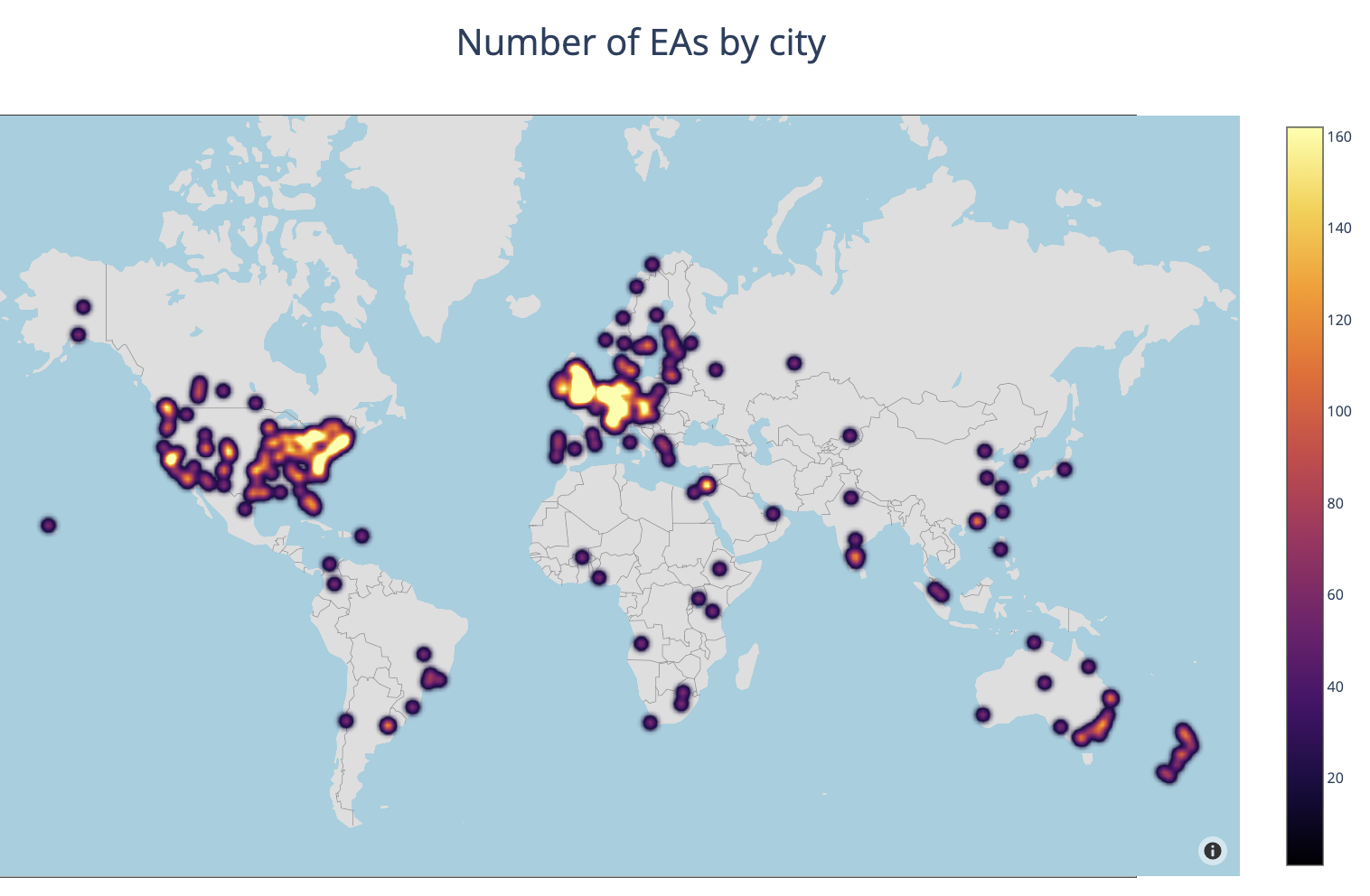
Nevertheless, there are at least 200 miles between each of these cities, and we did not spot any other major conglomerations of EA centres in this area. As such, there do not appear to be any closely related hubs in this area comparable to the SF Bay Area or Loxbridge (whose population centres fall within around 50 miles of each other).
Where do most highly engaged EAs live?
Using EA Survey data we can also examine where highly engaged EAs specifically live. This is worth doing as there may be different proportions of highly engaged EAs across different cities.
In the analysis below we look at the locations only of those EAs who self-reported the highest levels of engagement on a 1-5 scale in the EA Survey (414 respondents).
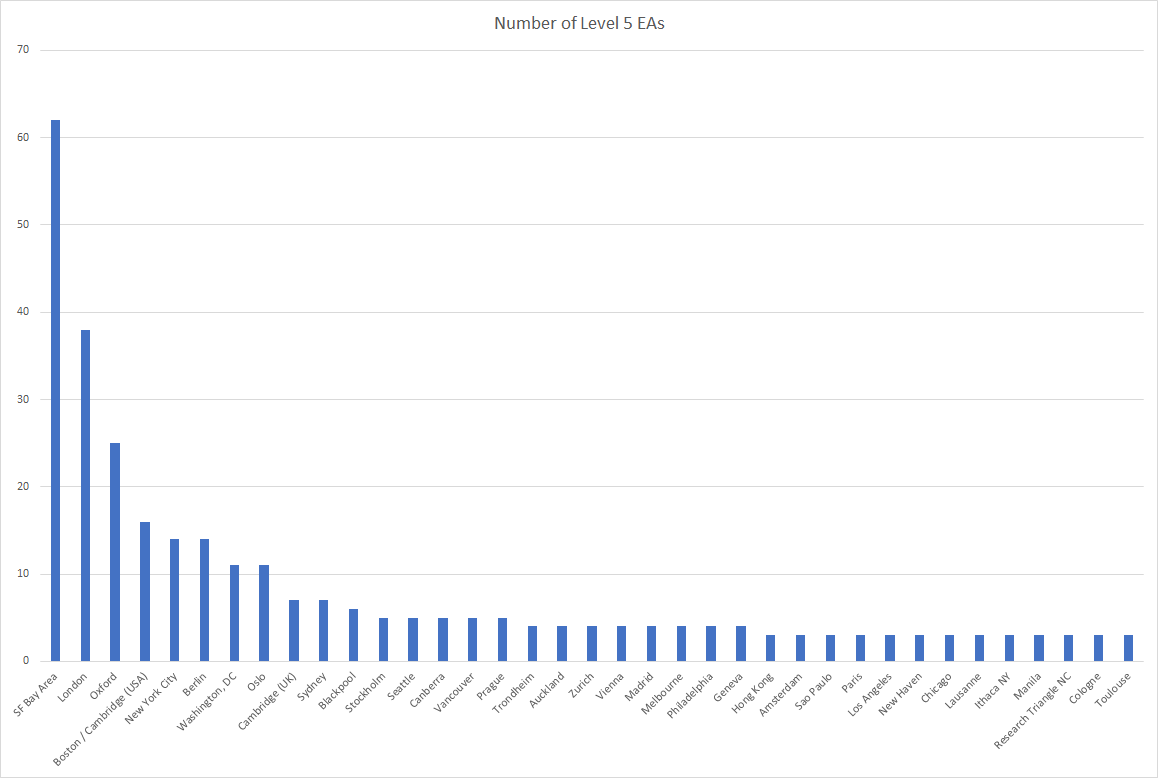
Full image here
The graph above shows those cities with more than 2 self-reported highly engaged EAs.
Looking only at those who reported the highest engagement level, we see that respondents are concentrated in a yet smaller group of cities. Indeed, of the 350 cities globally with at least one EA reporting living there, only 124 (35.4%) have at least one highly engaged EA living there and only 17 have 5 or more.
It is notable that there are very few cities with large numbers of ‘highly engaged’ respondents, with only 8 having more than 10. As such, it seems like it might be relatively easy for a new EA community to be founded that would quickly have among the largest concentrations of highly engaged EAs. For example, based on these results Blackpool is the city with the 11th highest number of highly engaged EAs, no doubt almost entirely due to the founding of the EA Hotel.
Looking at highly engaged EAs alone, the SF Bay Area is much more dominant, with 62 such respondents, considerably more than London’s 38. However, the ‘Loxbridge’ agglomeration continues to be larger than the Bay Area with 70 highly engaged EAs vs 62.
The ordering of the largest cities also changes significantly. Oxford is now EA’s third city, with 25 to London’s 38. New York City, the city with the 3rd largest population of EAs, is only the 5th largest in terms of self-reported highly engaged EAs, having less than a quarter of the SF Bay Area’s total, with 14 such respondents. Likewise, Cambridge and Blackpool climb the rankings, having relatively small but disproportionately highly engaged populations, with 7 and 6 highly engaged EA respondents respectively.
It is important to note, however, that the highest category of the self-reported engagement scale may be skewed in important ways. The label for the “high engagement” category gave as examples that respondents “perhaps help[ed] to lead an EA group or work[ed] at an EA aligned organization.” As such, we would expect respondents to be more likely to select this category if they live in cities where there are EA orgs for individuals to work for or local groups for them to run, compared to otherwise equally highly engaged EAs living elsewhere.
A different measure, which we found to be a good proxy for engagement in our previous post was EA Forum membership. This suggests a similar pattern, with 11.9%[2] of Forum members living in the SF Bay Area and 15.25% living in Loxbridge, and so 27.15% of Forum members living in these areas combined.
Looking at only the most highly engaged EAs, it seems that the SF Bay Area and London account for about 24% of the total (a slightly higher percentage than when looking at all EA respondents), while the SF Bay Area, London, Oxford and Cambridge account for almost 1/3rd (32%) of highly engaged respondents.
What counts as an EA Hub?
As questions about ‘Loxbridge’ suggest, what counts as a meaningful EA hub is not straightforward.
Presumably which areas count as an EA hub depends in part on the practical purposes for classifying certain EA geographic areas. If you are considering where it would be most fruitful to help EA groups run events (e.g through funding organisers), then presumably it matters whether EAs within a certain area (which might be larger or smaller than a particular city) are likely to attend events. Alternatively, one may be interested in knowing how many EAs would be likely to benefit from the development of location-specific networks or resources. For example, developing the London EA community might benefit EAs living across London even if those not living centrally did not attend events (see discussion of the Community vs Network here). From the perspective of EA organisations, conversely, the core question of interest may be the availability of staff, which may involve much larger regional or cross-national areas. Alternatively, it might only make sense to analyse EA hubs at a sub-city level, if EAs within a city operate as more than one local community with little connection between the two.
Is the SF Bay Area a single EA hub? Is Loxbridge?
As the map below shows, the full SF Bay Area covers a considerably larger area than London, roughly comparable to the area between London, Oxford and Cambridge.

Full image: here. Oxford and Cambridge are found on the map on the right, mid way up the left hand side and in the top right hand corner respectively.
Nevertheless, the vast majority of EAs in the broader Bay Area seem to live within a much smaller area (more akin to the area of Greater London alone). Furthermore, anecdotally, a large majority of these live with an even smaller subset of areas near San Francisco (e.g. Berkeley and Oakland). Unfortunately, we lack information about the distribution of EAs across London in order to make a comparison.
On the face of it, it seems likely that London, Oxford and Cambridge do not form a particularly cohesive EA community, in terms of EAs from each of these regularly attending events at the others and thinking of themselves as part of a broader London-Oxford/Cambridge EA community, rather than as part of a London/Oxford/Cambridge community. For example, it seems like local events are mostly advertised within one of these groups, rather than to all. In contrast the Bay Area seems somewhat more cohesive, with a large ‘Bay Area EA Facebook’ group, although there are some specialist subsidiary groups (for example, a smaller South Bay group). More research could be done to better understand how closely connected these various groups are. For example, we could survey EAs living in the various parts of the SF Bay Area, and in London, Oxford and Cambridge, to identify how often individuals attend events or visit other EAs in each of these respective areas.
Conclusions
The EA community remains fairly concentrated in certain key areas. This is even more the case when looking only at the most engaged EAs, with almost ¼ (24%) living in the SF Bay Area and London and almost ⅓ (32%) in the SF Bay Area and Loxbridge. Likewise, just under ½ (46%) of all EAs live in just 16 cities, while 49% of the most engaged EAs live in just 10 cities.[3]
This concentration of EAs in a small number of areas might be taken to suggest that the EA community could be served quite efficiently by investing community building resources in a relatively small number of areas, since a small number of cities seem to account for about half of people in the EA community. That said, there are some important caveats to bear in mind.
Firstly, as we noted, these figures probably somewhat overstate the extent to which EAs are concentrated in a few areas, because we would expect EAs living in the main hubs to be more likely to take the EA Survey and to indicate their city. However, we would not expect this effect to be too drastic; for example, we would expect the true percentage of EAs living in the SF Bay Area of London to be lower than 16% but higher than 12%. People might reasonably disagree about this if they think that considerably more EAs who don’t take the EA Survey live outside of these main EA population centres.
Another concern is that our analyses of ‘highly engaged’ EAs based on self-report might be skewed towards core EA Hubs in virtue of the fact that these have better access to EAGs and more EA orgs to work on, and so EAs living in these areas may be more likely to select higher engagement levels relative to those living elsewhere. As such, we think the identification of more engaged EAs in these areas may partly reflect the existence of more EA orgs and broader EA infrastructure in these areas rather than EAs living in these cities being more engaged in other respects than EAs living elsewhere.
It is also important to bear in mind that although close to half of EAs are based in only 16 cities, this leaves a very large percentage of the EA community living elsewhere. However, due to the smaller size of the remaining EA communities, while 46% of respondents live in the first 16 cities, the remaining EAs are spread much more diffusely over the remaining cities: only 15% live in the next 21 and 13% in the next 37 cities after that (for more details see Appendix 1). Nevertheless, many of these cities contain a significant number of EAs, with 58 containing between 5 and 19 EAS respondents, and around 500 respondents living within cities within these two groups, which in line with our earlier post implies that the true number of EAs living in these cities is somewhat higher.
It is also possible that community building resources have equal or higher returns in smaller EA communities, which may be less developed and more in need of support to promote their development. It also seems worth noting that many EA communities are quite new and some that are now quite large seem to have grown quite rapidly in recent years. As such, investing in a wide variety of currently only modestly sized EA cities may bear future dividends.
Another consideration to bear in mind is that over time, the EA community has been growing more rapidly outside of the main EA Hubs. Earlier cohorts of EAs seem to have contained much higher percentages of respondents from the main EA hubs (up to 50%), whereas over time this has declined dramatically, with 90% of newer cohorts coming from cities other than the main EA hubs.

If this trend continues, and if more current EAs become highly engaged with time then in the future, larger proportions of EAs and larger proportions of highly engaged EAs will likely live outside the traditional core hubs of the EA community.
Appendix: How many EAs live elsewhere?
The number of EAs living in only the SF Bay Area or Loxbridge is clearly disproportionate, but still clearly a relatively small minority of EAs overall. As the EA Survey Geography post showed, a much greater proportion of EAs live in “Other” cities, with fewer than 10 EA respondents (40% of respondents to the city question).
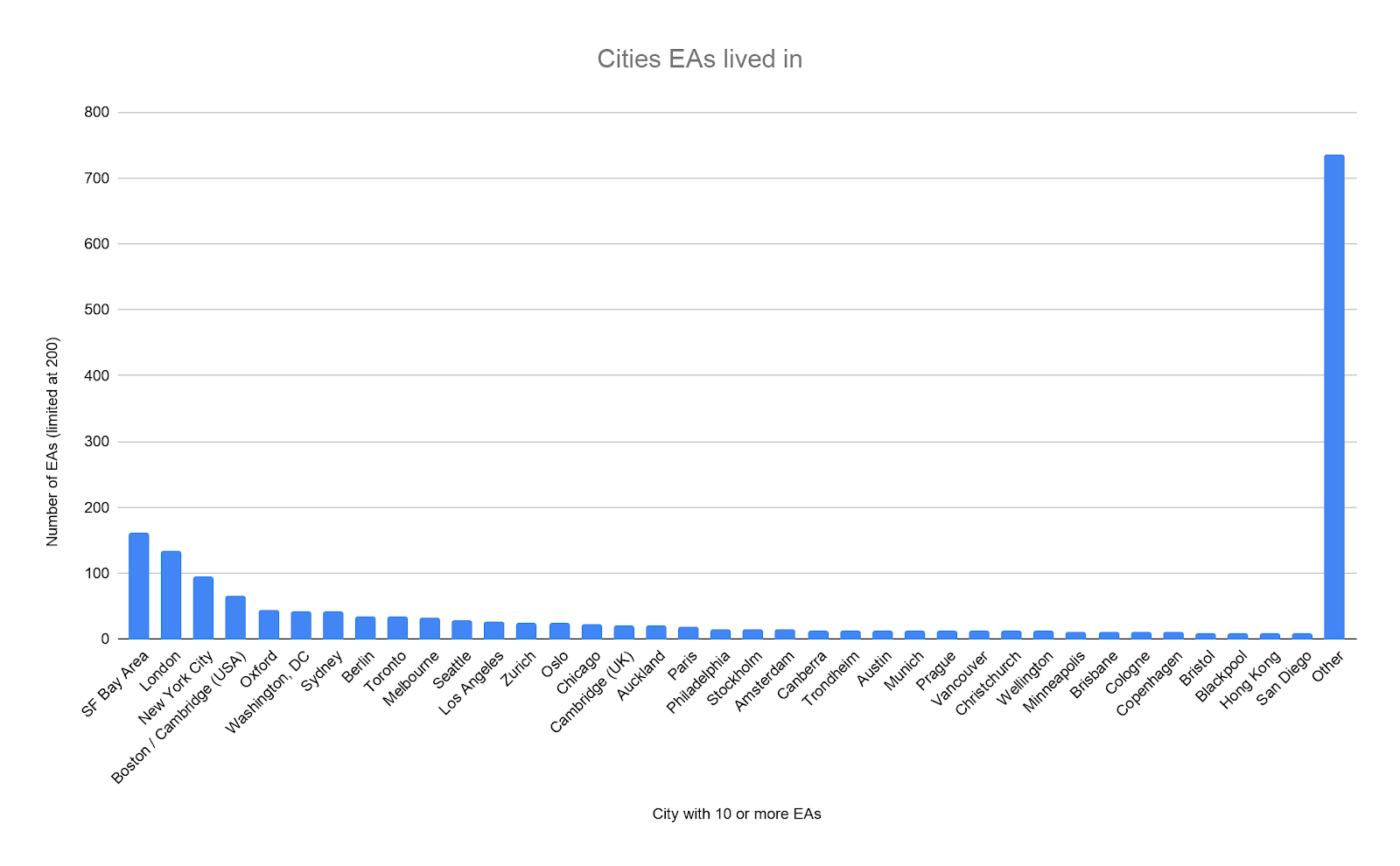
We can get a better sense of the overall distribution of EAs across cities with the cumulative percentage graph below.
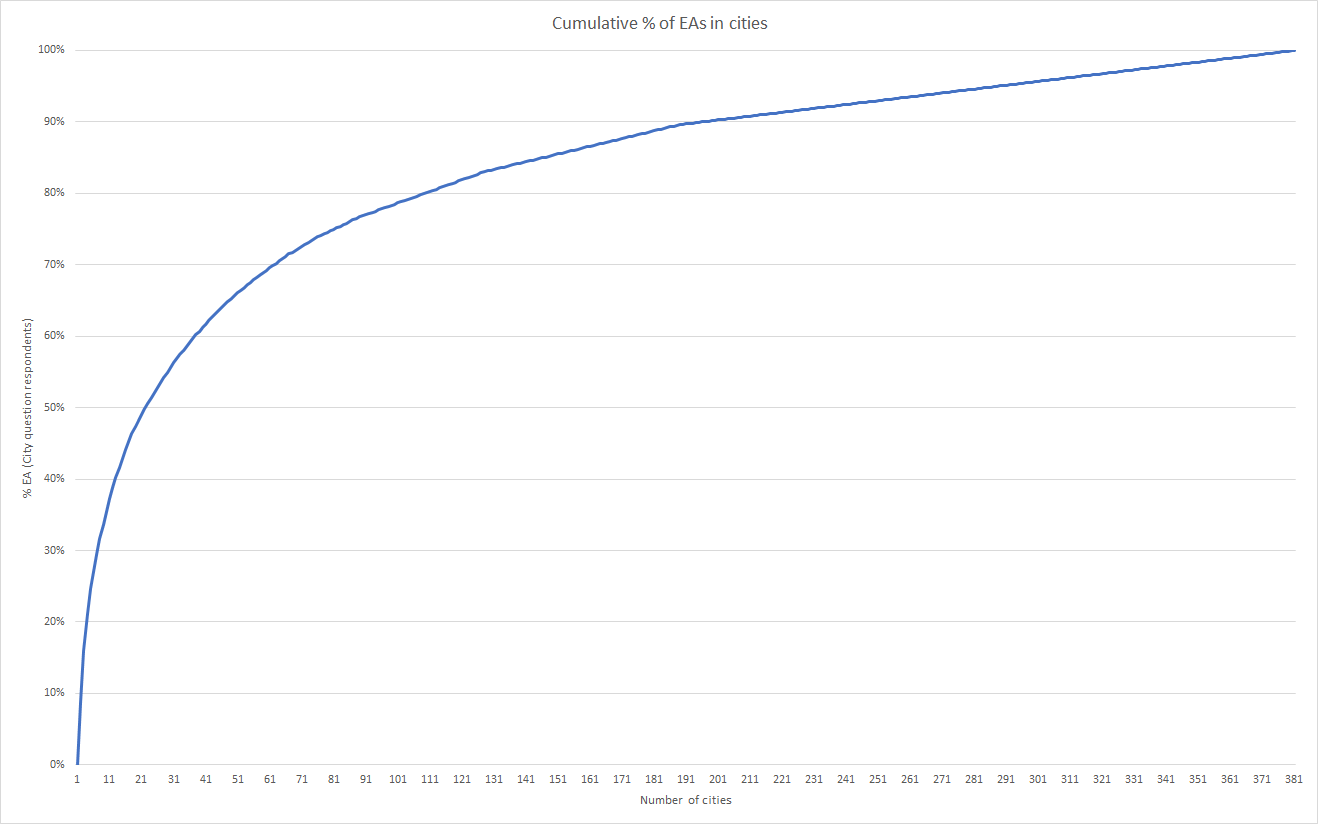
As the graph above shows, more than half (50.59%) of EAs who responded to the survey live in only 22 cities, while around 80% of respondents came from 100 cities.
To get a clearer sense of how many EAs live in cities of different kinds, we categorise cities into some intuitive (though somewhat subjective) groups below.
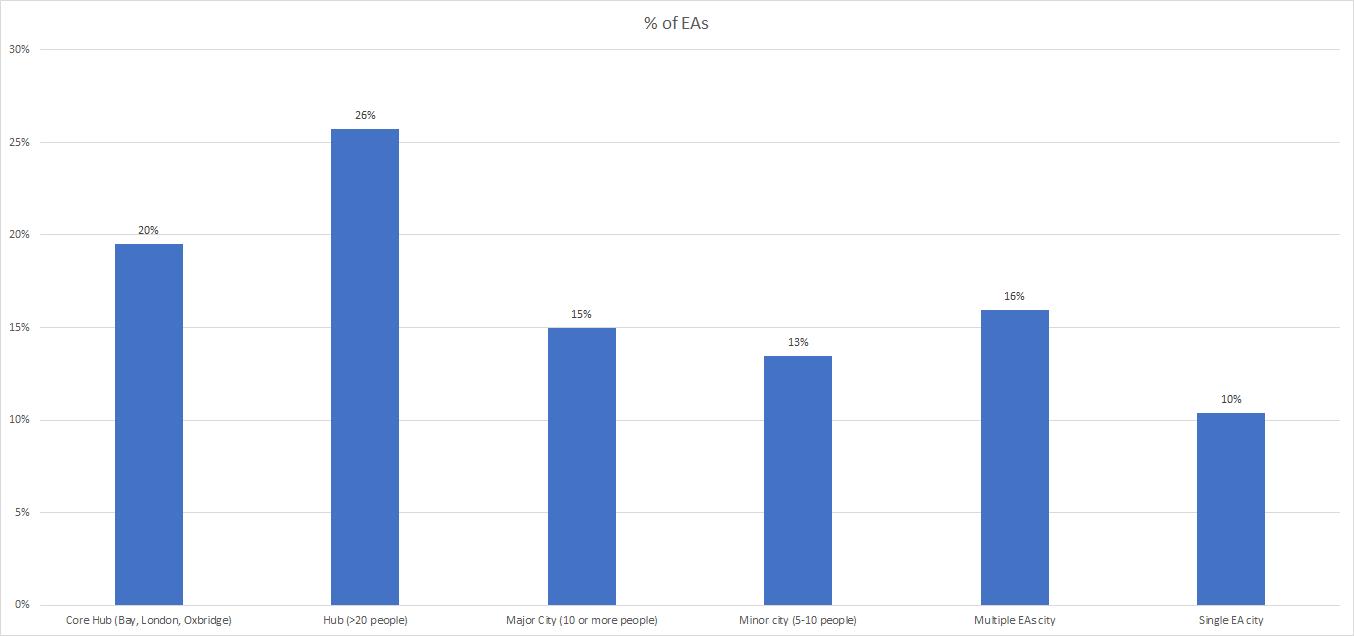
The first category of ‘Core Hubs’ grouping is particularly subjective, but contains the two largest cities mentioned above, the SF Bay Area and London, with Oxbridge (Oxford and Cambridge). Notably, due to their small size, Oxford and Cambridge make relatively little difference to the total size of this group, accounting for only 18% of the total SF Bay Area + Loxbridge group.
The next category refers to ‘Hubs’, which contains the 12 other cities with >20 EA respondents: New York (95), Boston/Cambridge (USA) (66), Sydney (43), Berlin (35), Toronto (35), Melbourne (32), Seattle (29), Los Angeles (26), Zurich (25), Oslo (24) and Chicago (23). This category is clearly somewhat heterogenous, containing very large cities such as New York city, with smaller EA communities, containing about a quarter as many EAs.
Of note, almost half of EAs (46%) live within either the 4 ‘Core Hub’ cities or one of these 12 further ‘Hubs.’
The next group, ‘Major EA Cities’ contains all those cities with 10-20 EA respondents, which is 21 cities in total, including Auckland (20), Paris (19), Amsterdam (15), Vancouver (13), Copenhagen (11), Blackpool (10), Bristol (10) and Hong Kong (10). This group contains only 15% of total EAs.
The next categories, ‘Minor Cities’[4] (with 5-10 EA respondents), which contains 37 cities, and ‘Multiple EAs Cities’ (with more than 1 EA respondent), which contains 114 cities, each comprise only 13% and 16% of respondents respectively. 10% of EAs live in the 192 ‘Single EA’ cities, with only 1 EA Survey respondent.
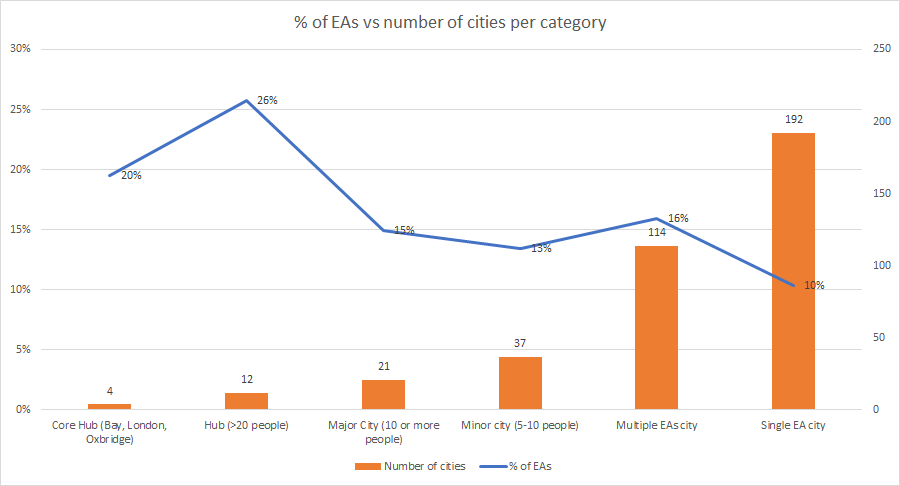
As such, we can see that, while almost half of EAs appear to live in around 16 cities, and a further 15% live in the next 21 cities, there are significant numbers in roughly equal proportion across the next categories.[5]
Credits

The annual EA Survey is a project of Rethink Charity with analysis and commentary from researchers at http://rethinkpriorities.org/. This essay was written by David Moss. Thanks to Catherine Low, Neil Dullaghan, Peter Hurford, and Kim Cuddington for comments.
We would also like to express our appreciation to the Centre for Effective Altruism and the EA Meta Fund for supporting our work. Thanks also to everyone who took and shared the survey.
If you like our work, please consider subscribing to our newsletter. You can see all our work to date here.
Other articles in the EA Survey 2019 Series can be found here
Notes
We expect EA Survey respondents who live in the main cities to be more likely to have answered the question for a number of reasons: i) it would be easier to do so, because the big cities were offered as ‘fixed’ options, whereas those living in unlisted cities had to go to the extra effort to write in their responses, ii) EAs living in the larger EA cities were, on average, higher in engagement than other EAs and as we noted in our earlier post, we expect that we would have sampled a higher % of more engaged EAs and, in addition, we would expect EAs in major hubs to be better connected to other EAs (who might inform them about the survey) and to local groups (who were another vector for recruitment) iii) EAs living in smaller cities would be expected to have more privacy concerns related to revealing their city than those living in ones with many more EAs. As such, we would expect the true % of EAs living in the main EA cities to be lower than the % listed in the second column above. We would expect the % of EA Survey respondents who live in these cities to also be higher than the number in the third column, because it is implausible that none of the respondents who declined to answer that question lived in the major cities. The proportion of the true population of EAs (however that is defined), beyond the EA Survey sample, living in the main EA cities, is of course even less certain, though it could well be lower than either of these percentages. ↩︎
All percentages in this section are of respondents who answered the Engagement question and who answered the City question. ↩︎
SF Bay Area, London, Oxford, Boston/Cambridge, New York, Berlin, Washington DC, Oslo, Cambridge (UK) and Sydney. ↩︎
Of course, these are categorised as ‘Minor Cities’ in virtue of their number of EA respondents, yet while they are on the whole smaller cities than the ‘Major Cities’ (which are all fairly major cities in non-EA terms), some of the ‘Minor cities’ are quite large, just not in EA terms (e.g. Sao Paulo, Madrid, Barcelona, Montreal). ↩︎
One thing that could potentially be missed from our analysis of cities that EAs report living in, is that there may be significant EA communities built around universities, with EA Survey respondents potentially citing their hometown as the city they live in, while spending term time at a university located elsewhere. We cross-referenced our City results with the Local Groups Survey and did not notice any groups with particularly large number of ‘highly engaged EA members’ which did not have a corresponding city among the larger city categories. ↩︎

I think some people might look at this to choose which EA hub to live in or where to found an organization (of course, not everyone can/should live in a hub).
I think it is easy to overlook the density of EAs when making such a decision: e.g. Oxford's population is ~60x smaller than London's and its land area is maybe 100-300x smaller. So the travel time to visit another random EA tends to be much lower, and it's a lot more likely that you bump into people on the street. (My impression is that Berkeley is somewhere between Oxford and London, but I don't know the details.)
Thanks for the comment Max.
EA density is definitely something worth considering. We reported this for the main EA cities in the 2018 Geography article (graph below) and you can see the graph for 2019 below that.
Of course, as I discuss in the 'What counts as an EA Hub?' section, what characteristics matter in identifying a hub will depend on your practical purposes: as you say, density probably matters more if you are looking for somewhere to live and want to bump into random EAs on the street, but I would imagine less so if you are looking to found an organisation and want an accessible pool of people to hire from.
I imagine that if you are thinking about travel time and likelihood of bumping into people randomly, functional density is probably also higher in some of these cases, due to EA populations already being very localised within certain parts of cities.
Thanks for the extra analysis, that's interesting. Good point that it depends on your purpose.
Also, just to be clear, I didn't intend this as a criticism of the OP at all - this point just came up in conversation yesterday and I thought it was worth sharing! I find these posts really helpful and keep coming back to them as I think through all sorts of problems.